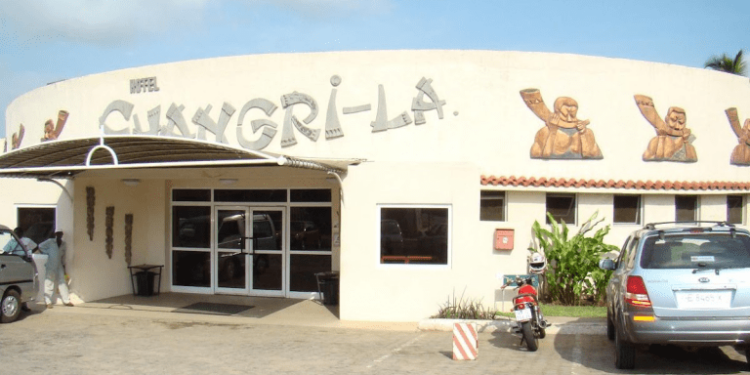Shangri-La: The Most Twisted Hotel Saga in Ghana
If you are of a certain age and know Accra a bit, you must know Shangri-La. A cute, low-rise, hotel along the northern stretch of the Liberation road, and on the doorstep of what later became the Israeli-built Tetteh Quarshie Interchange and, a few years later, the Accra Mall. If you are middle-class enough, you may even remember the legendary “pizza by the pool”.

In its heyday, Shangri-La, nestled daintily in the city’s swanky airport district and touching the northernmost edge of its old colonial charm amidst the stables of the Polo Club, was indeed the classy choice of the aspirational set. But by 2011, it was being dissed by this same crowd and described as worthy of bulldozing. It will linger on for a few more years before its demolition.
Following its demolition more than a decade ago, the land has been lying fallow. Many Accra residents who ply that stretch of Liberation Road must have wondered every time they see the bus-stop sign why such a disheveled patch of land could be left where it is for so long considering all the plush structures in the surrounding area.
The more inquisitive would have noticed that Shangri-La is not the only abandoned hotel in the neighborhood. Nearby Granada has also been in a state of disrepair for at least the same length of time.
Few, however, would be aware of this intriguing story of the land on which both The Granada and the Shangri-La are located.
In the years when the fear of global epidemics made airports and seaports high-risk portals into towns, it was customary for harsh quarantine measures to be imposed at these entry points just as we saw at airports around the world in the early heady days of the COVID-19.
A bit of this history lives on in the discomfort that air travelers to Ghana feel when they have to endure the smell of insecticides designed to kill off yellow-fever carrying mosquitos before planes bound for the country take off. In ancient times, things were far less sanguine. Lacking our modern vaccines and whatnots, some towns would even sink ships and murder travelers docking at their ports if they suspected any vessels of carrying infections.
Anyway, the fear of disease spreading by air transport led to the creation of so-called “anti-amaryl aerodromes“, which are facilities for handling aeroplanes suspected to have originated from or transited disease-endemic ports. These special aerodromes were isolated from human settlements to the extent possible.
In 1936, the British colonial government decided to establish an anti-amaryl aerodrome in Accra and compulsorily acquired a large tract of land from the La Stool to do same. By 1944, however, the whole concept of anti-amaryl hangars had fallen out of favour. The International Sanitary Convention for Aerial Navigation would then proceed to more or less render it redundant.
Over the years, the state has found a way to parcel lands such as the one hosting the Granada, the Polo Club, and the Shangri-La and hand them over to private businesses under rather opaque circumstances.
One such beneficiary was Armen Kassardjian, the developer of the Shangri-La hotel in Ghana.
The Kassardjians are a legendary Ghanaian-Lebanese family of Armenian origin. When the patriarch of this storied family, Askor, first arrived in the colonial Gold Coast in the 1940s, he made what became Northern Ghana his base, soon becoming a construction magnate.
The elder Kassardjian would soon become embroiled in some of the titilating scandals of pre-Independence Ghana, especially the J.A. Braimah “bribes for road contracts” scandal.

Yet, the long history of his contributions to the built environment in Tamale, Navrongo, and elsewhere in the South is of such sheer pedigree that a few years ago, Ghana’s national archives decided to stage an exhibition of his life.
Other Kassardjians own various ventures across the country such as the Hillburi resort in Aburi, elevator engineering firms, and agro-commodities trading houses.
Whilst Armen Kassardjian has treaded the same entrepreneurial paths of his mighty clan forebears, in the matter of Shangri-La, the record is rather mixed.
In 1991, fresh off settling an economic sabotage indictment by the Office of Special Prosecutor with the PNDC government, via the National Public Tribunal, Mr. Kassardjian began to contemplate additional luxury real estate investments. Long before the likes of Villagio became a commonplace sight, he had his eyes on the future of upper middle-class living in modern residential complexes. His Palm Royale Apartments were poised to set a glamorous new trend.
Unfortunately, Ghana’s weak credit market tampered most of his dreams. Then one day he heard about the private-sector arm of the World Bank. Most business folks know of the Washington DC – based organisation only as a lender to governments. Of course, it also gives billions to entrepreneurs of the right calibre or endurance. Mr. Kassardjian was determined to get some of the nice dollars, whatever it took.














